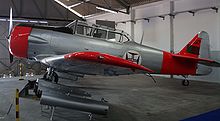North American T-6 Texan
Watanabe Tekkosho chose to ignore the NAA design almost entirely, and built 176 of the somewhat similar K10W1 from 1941 to 1942 which the Allies gave the code name Oak.Then in November 1939, the British Purchasing Commission ordered the first of eventually 1275 Harvard Mark IIs (NA-66, NA-75, NA-76, and NA-81) for the Royal Air Force and RCAF.The AT-6D, which was also armament capable, and early versions included a wing gun camera, and a high-pressure oxygen system.The Air Training Command received 641 aircraft, designated T-6G-NT, of which 416 eventually were sent to U.S. Military Assistance Program countries.Alternatively, they could carry the gun pods and 12 2.25 in (57 mm) SCA markings rockets, or 6 100 lb (45 kg) bombs.[12] The Canada Car and Foundry built 285 Harvard 4s, designated NA-186 under the Mutual Defense Assistance Program (MDAP) and an additional 270 directly for the RCAF.Peru used its seven T-6 fighter bombers in the Ecuadorian-Peruvian War equipped with two 7.65 mm (0.30 in) guns, while carrying up to four 116 lb (53 kg) bombs.They also engaged in air-to-air combat on a number of occasions, with a rear gunner shooting down an Israeli Avia S-199 fighter.Communist guerillas called these aircraft Ο Γαλατάς, O Galatas, 'The Milkman', because they saw them flying very early in the morning.A Harvard was the longest-serving RAF aircraft, with an example, taken on strength in 1945, still serving in the 1990s (as a chase plane for helicopter test flights—a role for which the Shorts Tucano's higher stall speed was ill-suited).The T-6G was also used in a light attack or counterinsurgency role by France during the Algerian War in special Escadrilles d'Aviation Légère d'Appui (EALA), armed with machine guns, bombs and rockets.On 16 June 1955, rebel Argentine Navy SNJ-4s bombed Plaza de Mayo in Buenos Aires, Argentina; one was shot down by a loyalist Gloster Meteor.[20] In 1957–58, the Spanish Air Force used T-6s as counterinsurgency aircraft in the Ifni War, armed with machine guns, iron bombs, and rockets, achieving an excellent reputation due to its reliability, safety record, and resistance to damage.The Pakistan Air Force used T-6Gs in the Indo-Pakistani War of 1971 as a night ground-support aircraft, hitting soft transport vehicles of the Indian army.In the early hours of 5 December, during a convoy interdiction mission in the same area, Squadron Leader Israr Quresh's T-6G Harvard was hit by Indian antiaircraft ground fire and a shell fractured the pilot's right arm.The World War II-vintage propellered trainers were pressed into service and performed satisfactorily in the assigned role of convoy escorts at night.The T-6 remained in service until 1995 as a basic trainer, mainly as a result of the United Nations arms embargo against South Africa's apartheid policies.[23] Argentina Austria Belgium Biafra Bolivia Brazil Cambodia Canada Republic of China (Taiwan) Chile Colombia Republic of the Congo Cuba Denmark Dominican Republic El Salvador France Gabon Germany Greece Haiti Hong Kong Honduras India Indonesia Iran Iraq Israel Italy Japan Katanga Lebanon Republic of Korea Kingdom of Laos Mexico Morocco Netherlands Mozambique New Zealand Norway Nicaragua Pakistan Paraguay Philippines Portugal South Africa Southern Rhodesia South Vietnam Saudi Arabia Spain Soviet Union Sweden Switzerland Syria Thailand Tunisia Turkey United Kingdom United States Uruguay Venezuela Kingdom of Yemen Yugoslavia Zaire Data from Jane's Fighting Aircraft of World War II.For example, converted single-seat T-6s painted in Japanese markings to represent Mitsubishi Zeros made appearances in A Yank in the R.A.F.























Beechcraft T-6 Texan IILuke FieldManufacturerNorth American AviationUnited States Army Air ForcesUnited States NavyRoyal Air ForceRoyal Canadian Air ForceSouth African Air ForceNorth American NA-16North American A-27Bacon Super T-6North American P-64trainer aircraftUnited States Air Forceair forcesBritish CommonwealthWorld War IIUnited States Army Air CorpsBritish Commonwealth air forceswarbirdairshowMitsubishi A6M ZeroNAS JacksonvilleCommemorative Air ForceU.S. Army Air CorpsPratt & Whitney R-1340 WaspCommonwealth Aircraft CorporationCAC WirrawayMitsubishi JukogyoImperial Japanese NavyKyusu and K.K. Watanabe TekkoshoJapanese Air Self Defense ForceJapanese Maritime Self Defence ForceCentral Flying SchoolBritish Purchasing CommissionPratt & Whitney R-1340-49machine gunoxygen systemdrop tankNoorduynLend-LeaseAir Training CommandMilitary Assistance ProgramU.S. National GuardKorean WarCanada Car and FoundryMutual Defense Assistance ProgramRAF AqirNo. 154 Squadron RAFRAF FowlmereSpanish Air ForceEcuadorian-Peruvian WarSyrian Air Force1948 Arab-Israeli WarAvia S-199Israeli Air ForceSinai CampaignSinai Peninsulaforward air controlRoyal Hellenic Air ForceGreek Civil WarSpitfiresHelldiversVietnam War"Mosquitos"No. 1340 Flight RAFMau Mauabove mean sea levelShorts TucanocounterinsurgencyAlgerian WarPortugalPortuguese Colonial WarPortuguese Air ForceAngolaMozambiquePortuguese Guineabombed Plaza de MayoGloster Meteor1963 Argentine Navy RevoltM4 ShermanIfni WarPakistan Air ForceIndo-Pakistani War of 1971South AfricaUnited NationsapartheidPilatus PC-7cockpit attitude displaysNorth American T-6 Texan variantsSmoke SquadronNational Archives of BrazilArgentinaArgentine Army AviationArgentine Naval AviationAustriaAustrian Air ForceBelgiumBelgian Air ForceBiafraBoliviaBolivian Air ForceNaval AviationBrazilBrazilian Air ForceCambodiaRoyal Khmer AviationCanadaRoyal Canadian NavyNational Research CouncilColombian Air ForceRepublic of China (Taiwan)Republic of China Air ForceChilean Air ForceColombiaRepublic of the CongoCongolese Air ForceCuban Air and Air Defense ForceDenmarkRoyal Danish Air ForceDominican RepublicDominican Air ForceEl SalvadorAir Force of El SalvadorFrance